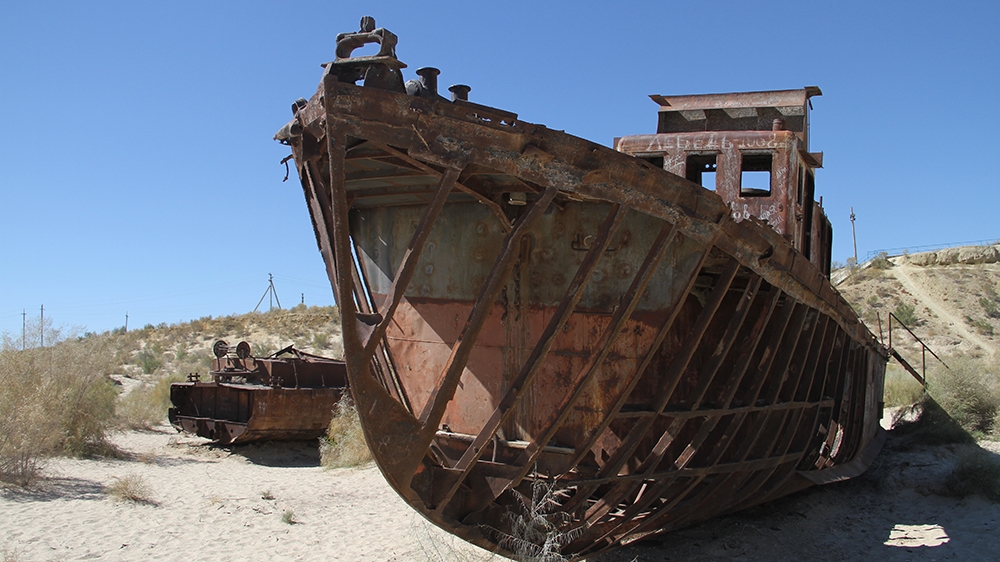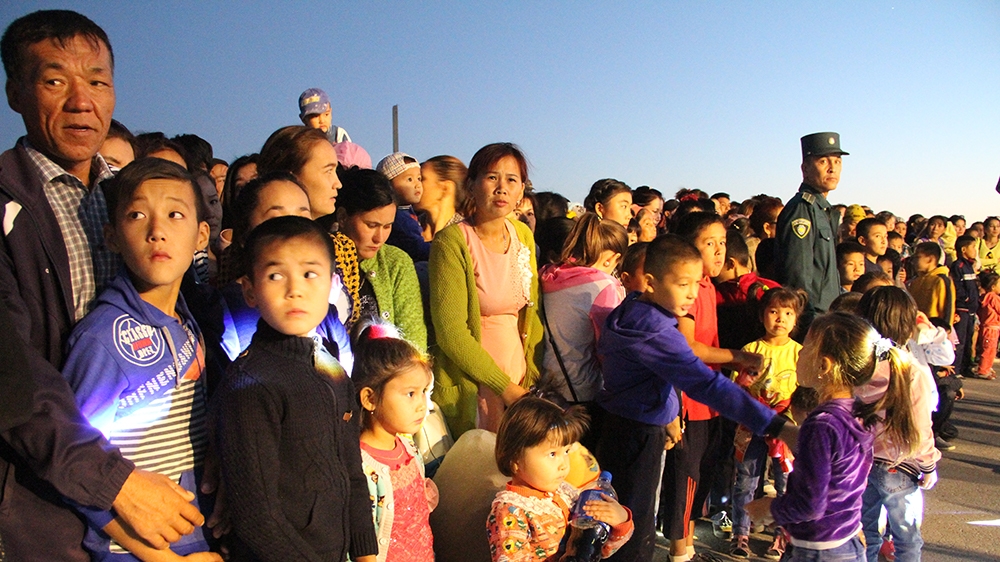Deserted Aral Sea hosts electro gig with environmental twist
Moynaq, Uzbekistan – The sun was setting over the ship graveyard in the town of Moynaq, Uzbekistan, when electronic music began thrumming through the air.
The warm, salty desert wind carried the sounds across the flat landscape, some 1,200 kilometres from the country’s capital, to the delight of thousands of spectators.
Friday, September 14 made history not only for the 13,500 local residents but also for Uzbekistan’s young generation.
The first electronic music festival in the country and the first music festival in Moynaq was an event many people had been waiting for.
Uzbekistan was until recently one of the world’s most isolated countries. Under President Shavkat Mirziyoyev, it has been gradually opening up.
The Stihia festival, with avant-garde sounds and ambient techno played by DJs from Berlin, Georgia, Russia and Uzbekistan, was part of the new vision.
The location was not accidental.
The ship graveyard, littered with the skeletons of vessels rusting away in the sand, is what remains of the mighty Aral Sea.
 |
| In the ship graveyard, old vessels lie rusting in the sand [Agnieszka Pikulicka-Wilczewska/Al Jazeera] |
It is a monument to one of the worst man-made environmental disasters.
The festival organisers wanted to raise awareness of the desiccation of the Aral and call for a more responsible approach in the notoriously water-hungry region.
Some attendees even believed the music might have a magical touch, hoping that perhaps techno beats and good energy could encourage the sea’s revitalisation.
Back in the 1960s, the Aral Sea fell victim to Soviet engineering projects.
Amu Daria and Syr Daria, two rivers that once flowed into the sea, were diverted to support the USSR’s growing cotton industry.
In 1954, Turkmenistan launched the construction of the Karakum Canal bringing water from the top of the Amu Daria river, across the Karakum Desert, to cotton fields and taps in the parched capital of Ashkhabad.
“Growing cotton, making textiles and growing wheat were more profitable than fish. So they did a trade-off,” Michael H Glantz, director of the Consortium for Capacity Building at the University of Colorado, and a long-time activist to save the Aral, told Al Jazeera. “The water sits there and evaporates anyway. So why not use it and build new canals, so that the water goes to the desert, which lacks water but is otherwise a productive soil?”
In Soviet times, the relationship between Moscow and the Central Asian republics had a colonial dynamic, where the peripheries’ scarce resources boosted the centre’s economic might.
“Do we care about some fish and fishing industry or do we want to feed the textile industry in Russia?” said Glantz. “The cotton used to go to factories in Moscow and other places on export, so it was a money maker. But the money didn’t go to the Uzbeks or Turkmen”.
 |
| People from all over the Karakalpakstan region attended the festival [Agnieszka Pikulicka-Wilczewska/Al Jazeera] |
As a result, Moynaq, a thriving port and one of the most important fishing industry towns in the former Soviet Union, sank into oblivion.
By the mid-1990s, the coastline retreated over 100 kilometres and the sea lost three-quarters of its water. Soon after, all the fish died.
The Aral Sea disaster destroyed the town’s main source of employment, which resulted in high outward migration.
Before the fish factory finally closed down in 1998, its employees were processing imported fish.
Today, the ship graveyard, where local boys hang out, is the last reminder of the town’s lost identity.
The sea’s decay also had environmental consequences.
The runoff from the cotton fields left the ground waters in Moynaq contaminated with chemicals, pesticides and fertilisers, which affected the local population’s health.
The area turned into a salt desert where dust storms rage for over 90 days a year, spreading poisonous salts.
“During the perestroika time, the Aral Sea catastrophe was seen as analogous with Chernobyl, since both radioactive substances from Chernobyl and blown-away sands from the bottom of the dried-up Aral Sea could be found all over the Eurasian Continent,” Tetsuro Chida, associate professor from the Nagoya University of Foreign Studies, told Al Jazeera.
“The Soviet scholars and authorities had foreseen the shrinkage of the Aral Sea when they took developmental measures in the basin, but they did not know what would happen as a result of its diminishment,” Chida said.
Muhabbad, a 35-year-old resident of Moynaq, says the effects of the sea’s decay are felt daily.
“The weather is getting worse every year. The water is salty and undrinkable and we are suffering from various health issues,” she told Al Jazeera. “Oncological diseases have become way too common.”
She attended the music festival with her 15-year-old niece Sabrina. While they enjoyed themselves, Muhabbad said the future of Moynaq is unclear.
“We would like other countries to help us to address our problems. But I don’t know if it can happen. I’m 35 and I have never seen the Aral Sea,” she said.
It’s like with climate change. No one wants to give up on fossil fuels or coal. And the same is with the Aral – no one wants to give up water. So who is going to make the sacrifice?
Michael H Glantz, director of the Consortium for Capacity Building at the University of Colorado and activist to save the Aral
For those who came from Tashkent, the capital, the event provided a reason for many to visit a faraway corner of the country and take a closer look at the effects of the environmental catastrophe.
“The people who listen to electronic music and who came from Tashkent and Samarkand are young professionals. They read a lot and their voice is important,” said Anna, a journalist from the capital, told Al Jazeera.
“It’s clear that we cannot change the situation, but we can draw some lessons from the catastrophe. We understand that the misuse of resources had caused a global problem. We have to learn from the past to avoid the same mistakes in the future.”
At present, both the UNDP and the Uzbek government are trying to address the effects the ecological disaster has had on local populations.
Their efforts focus on improving people’s health, education and environmental security, promoting entrepreneurship and developing local infrastructure.
Thanks to a dam built between the northern and southern parts of the sea, Kazakhstan managed to save its own part of the Aral. That dam, however, has disrupted the flow of water into Uzbekistan.
There is little hope that the Aral Sea will return to Moynaq.
“The Uzbeks, the Turkmen, the Kazakhs and then the Tajiks would all have to agree to give up water for irrigation of cotton, wheat, rice and just let it flow to the sea. It would take decades of sacrifice to refill it,” the University of Colorado’s Glantz said.
“It’s like with climate change. No one wants to give up on fossil fuels or coal. And the same is with the Aral – no one wants to give up water. So who is going to make the sacrifice?” he asked. “It is hard to save something that’s not there.”




